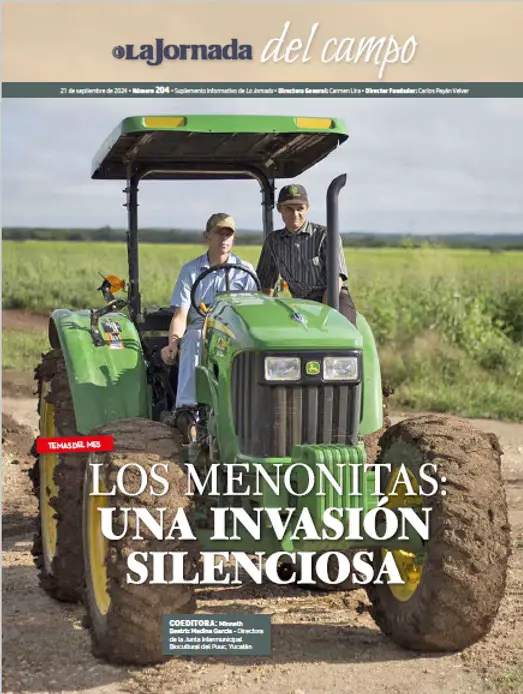The deforestation of the jungles in the Yucatán Peninsula has a major culprit in the primary sector: the Mennonite communities that, in this first quarter of the century, have monopolized lands (bought or rented) for intense and destructive agro-industrial activities, as highlighted in a special supplement of La Jornada del Campo. We recover fragments of their texts on the severe impacts of Mennonite expansion in both states.
The arrival and expansion of Mennonite communities in the Yucatán Peninsula began in 1987. They came from different places and for various reasons. Some came from Belize, where they dominate 90% of poultry and cereal production (corn and soybeans), making them the country’s food engine, to have lands they could live on as newlyweds.
Others came from Durango, as they disagreed with accepting the use of technologies; from Chihuahua, escaping water scarcity and insecurity; and from Zacatecas. Currently, they live in 52 communities in Campeche and 7 localities in Quintana Roo. In Yucatán, there is no record of resident Mennonite population, but itinerant camps are recognized in the municipality of Tekax.
The characteristics of the mechanized and intensive agriculture they practice, of an industrial nature, have made them the main executors of the agro-industrial model in the region. They implement monoculture systems (corn, soybeans, sorghum, oil palm, among others), use hybrid or transgenic seeds of soybeans and corn (prohibited in the country), as well as fertilizers and pesticides, such as glyphosate.
Hopelchén was the municipality with the highest soybean production nationwide in 2022, with 49,870 hectares planted and 97,246 tons of production, a larger area than Tlalpan with 31,200 ha (the largest borough in Mexico City), followed by Campeche, Tekax, Tizimín, and Bacalar.
The contribution of the Mennonites in 2018 represented 90% of Campeche’s production.
Reasons for Mennonite Expansion in the Region:
– Productive reconversion by preferring to cultivate soybeans instead of corn;
– The push for mechanized agriculture as opposed to traditional agriculture (as they have more capital and technology, displacing local producers through productive exclusion);
– Government subsidies, where Mennonites are recipients of productive promotion programs, facilitating the acquisition of inputs and credit.
Meanwhile, the region is advancing in the vertical integration of production processes oriented towards export to Eastern countries. They start with the cultivation of corn, soybeans, and sorghum, which supply the agro-industry (companies like Proteínas y Oléicos, Hidrogenadora del Sureste, Enerall, Grupo Kúo, among others) used in processed food chains that supply the pork and poultry industries, as well as the oil industry, with the support of Cargill at least in the construction of storage plants.
Thus, the link between Mennonites and the agro-industry is mutually reinforcing, supported by productive promotion programs such as Agriculture by Contract and the Pro-Oilseeds Program.
Mennonites and Neoliberalism in Maya Land: Verónica Martínez
What began in Hopelchén, Campeche, with a few hectares in 1988 with the Mennonites, has now expanded to 61,200 hectares in Campeche, Yucatán, and Quintana Roo dedicated to extensive agriculture, mainly soy and corn, according to the latest agricultural year reported by the Secretariat of Agriculture (SADER).
Although not all these lands belong to Mennonites, extensive agriculture is implemented; this involves the use of pesticides, herbicides, and, if permitted, openly using transgenic seeds.
The tradition and culture of the Mennonites involve migrating; moving and settling in fertile and prosperous lands. It all begins with an advance trip that explores, analyzes, investigates, and starts with renting or buying jungle lands.
In Hopelchén, Campeche, they arrived in the middle of the Maya jungle, and their migratory, organizational, and hardworking culture allowed them to quickly settle by building homes, schools, churches, and stores, and from the very beginning, they worked the land.
The type of agriculture the Mennonites know and master is extensive, involving single-crop farming on large tracts of land, as they learned in Northern Mexico: Chihuahua, Tamaulipas, Zacatecas, as well as from German lands.
Each year, an average of 1,500 hectares of the Yucatán Peninsula has been integrated into this agricultural model, which found support, rewards, and recognition during neoliberal governments.
The agricultural zone of the Yucatán Peninsula was not characterized by large volumes of corn or soy production but by the Milpa Maya, seasonal production with the richness of various crops in the plots. However, the large productions of soy and corn by the Mennonites attracted some investors who joined extensive agriculture, sidelining the richness and biodiversity of the milpa.
The corn and soy from extensive agriculture have guaranteed buyers because the most important pork and oilseed industries in the country are in Yucatán, ensuring secure buyers.
Dimensions
SADER statistics show that in the last agricultural year, 61,200 hectares were allocated to soy production, achieving a harvest of 125,500 tons, all purchased by the pork, poultry, and oilseed industries.
The main pork company is Kekén of Grupo Kuo, the oilseed company is Proteínas y Oléicos, and the poultry companies are Bachoco and Crío.
Source: La Jornada de Oriente




